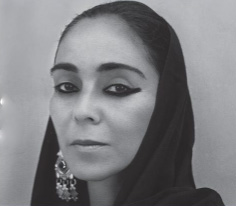
Shirin Neshat (born on March 26, 1957 in Qazvin) is a contemporary Iranian photographer and filmmaker. She won the Silver Lion award at the Venice Film Festival as the best director for Women Without Men. Shirin Neshat currently lives in New York.
Shirin Neshat was born in Qazvin in an educated and somewhat religious family. In 1974, she went to America to continue her studies and studied art at the University of California, Berkeley. During the 80s, she was the director of New York Art and Architecture Exhibition Company. During this period, she analyzed the role of gender in determination of spaces (and vice versa) and the meanings of physical space by holding exhibitions such as Werchitecture, and photographs of damaged buildings in Sarajevo, a theme that found its way into all her films.
In 1990, when she returned to Iran for the first time, under the influence of fundamental changes in the country, she decided to record her impressions of these changes, especially about women. She prepared the series of “Women of Allah” photos for this reason. In these photos, in which she played a role, explored the martyrdom in Islam by leaving aside the common stereotypes about Muslim women. In the following years, she made three black and white video installations called “Rebellious” (1998), “Attraction” (1999) and “Passion” (2000). This trilogy considers the dynamics of relationship between men and women in Islamic societies. According to herself, in these films, by placing subject in a new context within a philosophical and poetic context, she recreates it.
In 2001, American composer Philip Glass asked her to make a film for which he would compose music. Influenced by watching television images of Palestinians and Israeli soldiers’ conflict, she made an eleven and a half minute color film “Curved Passage” which was accompanied by the a soundtrack made by Glass. In the same year, she made a black and white video installation called Crazy about separation and passion, and Pulse about private and public identities. Among her works, a combined work based on the Masnavi of Mateq-al-Teir Attar can be seen.
Neshat’s works have native roots from Iranian life and society, and she has created many works about life and situation of Iranian women. In her works, she uses feminine motifs that Iranian women use to express their emotional feelings in the form of poetry on their palms and feet. Shirin Neshat is a well-known figure especially in Germany. After Parastoo Forohar, she is the second Iranian woman whose works were able to enter Berlin Museum of Contemporary Art. Despite the fact that many of the most famous painters and artists in Europe and America have not yet succeeded in.
Awards
In 1999, she won the international prize of the 48th Venice Biennale (a golden lion).
In the 2014 session of the World Economic Forum, she gave a speech as one of the three influential cultural leaders of the year. In her speech, she addressed the then president of Iran, Hassan Rouhani, and read a message in support of the promotion of Iran’s artists and cultural status.
She is currently making a film about the life of Umm Kulthum, a famous Arab singer. The production of her film began in fall 2013 in Egypt. As a director, Neshat hopes that the funds for the film will be provided by Arab countries of the Middle East
Movies
2017 – In search of Umm Kulthum
2009 – Women Without Men (Shirin Neshat’s first long film)
2005 – Zarrin / starring Behrouz Voshoughi
2004 – Mahdokht
2003 – The last word
2002 – Passion
2002 – Crazy
2002 – Tuba
2002 – Manteq-Al-Tayr
2001 / 2002 – Curved passage
2000 – Monologue
1999 – Attraction
1998 – Turbulent

